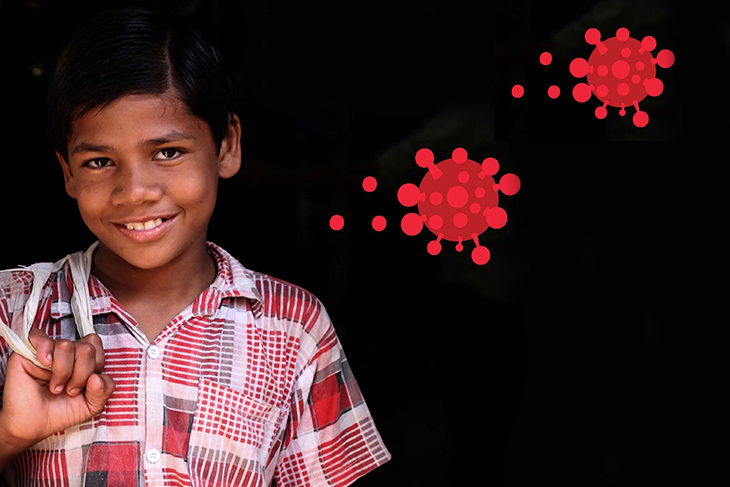One fine morning last week, while I was buying vegetables from my neighborhood at Kudghat, Netaji Nagar, Kolkata, I met Suman Mandal, a young boy of 20 years, with his cycle-cart selling vegetables. He had placed his vegetable cart outside the vegetable market, next to a temple. It was a bit inconvenient in these days when people wanted to avoid crowds to prevent the risk of contracting COVID-19 infection. Suman was a bit scared too, as women from the temple, probably belonging to the temple staff family, repeatedly cautioned him not to stand in front of the entrance to the temple.
In the conversation while buying vegetables from Suman, I learnt more about him. Born and brought up in Kolkata and living with his parents and younger brother, Suman is a first-year student at the nearby day college. Suman’s father, who worked as a mason at construction sites, had no income amid the lockdown, and so Suman began working as a vegetable vendor to support his family. Suman does not possess a smartphone and lacks access to any of the online study platforms.
The challenges faced by Suman, drove home to me the challenges faced by informal workers and students due to the lock down called as a response to the COVID-19 pandemic.
On March 24, 2020, the Government of India ordered a nationwide lockdown for 21 days, limiting movement of 1.3 billion people as a preventive measure against the spread of COVID-19 pandemic. That was the time when the number of confirmed positive coronavirus cases in India was approximately 500. The nationwide lockdown continued till May 3, 2020 after which the next phase went on with different controlling measures along with a few relaxations, with the intent to contain the spread of the pandemic. Presently, as of June 23, 2020, the number of total active cases of COVID is more than 1.78 lakhs with a total count of confirmed cases arching over 4.5 lakhs.
During the lockdown, all private and public services were suspended with exceptions made for movement of those transporting and delivering essential goods and emergency services like medical including ambulances, fire, and police. People were advised not to step out of their homes. The whole country witnessed an unprecedented manifestation of this lockdown that affected the various sections of people differently. The worst-affected were the millions of workers who faced the loss of livelihoods and income, food shortage, and mounting uncertainty regarding their future, resulting in countless families even suffering due to hunger. According to an informal Group of Ministers report, by the third week of May, there were 93 million urban informal workers among the hardest-hit due to the sudden lockdown.
Suman’s father’s fate is shared by millions of other workers in the construction industry. India has 54 million construction workers out of which only 35 million are registered under the labour welfare board. Hence, any relief or direct financial assistance announced by the government would not reach the unregistered 19 million. Moreover, there are the usual operational issues for people who are disadvantaged economically who continue to remain unregistered under the welfare schemes, making it harder for them to access the promised social security entitlements. In young Suman’s case, the need to feed his family compelled him to shoulder the responsibility due to which he had to even sideline his education.
It is perfectly understandable as the other hard-hit sector was our education system. All educational institutions remained closed and continued to loom within the uncertainty for regular curriculum. The lockdown presented unprecedented challenges on many levels – governments, institutions, teachers, parents, and of course students after which virtual classes emerged as a quick-fix solution for maintaining continuation of class curriculum for students. India comprises over 320 million students who fell victim to this lockdown. Presently, given the COVID-19 situation, it is still uncertain whether they can resume their regular classroom learning systems. The country is now witnessing a rapid expansion of e-learning without calculating our potential as a nation to adopt this e-learning system.
While virtual education can be an ad-hoc solution for a small period, we need to do some rethinking to find solutions that are longer-term and inclusive of the large majority that doesn’t have access to power, computer/smartphones and the internet. If we look at the data from Key Indicators of Household Social Consumption on Education in India report, based on the 2017-18 National Sample Survey, these are the findings: Rural households with a computer: 4.4%; Urban households with a computer: 23.4%; Rural households with the internet: 14.9%; and Urban households with the internet: 42%. We need to remember that households living in extreme poverty cannot afford a smartphone or a computer, and therefore, promoting the virtual classroom model needs a careful re-assessment and redesigning in order to ensure access to education for all.
With more than 50% of our population below the age of 25 and more than 65% below the age of 35, we are a young nation. While the pandemic continues to negatively impact us all, I hope we would be able to overcome it through thoughtful and strategic actions, without simmering the aspirations of millions of young girls and boys for a better life.
In the face of loss of family income, and the challenges of engaging with education processes in the lockdown era, Suman represents how the aspirations of young India and not being adequately met by the COVID-19 response that we have been able to make as a country and as a society. The brief conversation I had with Suman led me to understand the need for us to come together to deal with depleting livelihood options for millions of Indians, and helping ensure education processes become more meaningful for children and youth of vulnerable communities.
Disclaimer: The article was originally published on India Education Diary. The views expressed in the article are the author’s and do not necessarily reflect those of ActionAid India.
 Author: Ashok Kumar Nayak
Author: Ashok Kumar Nayak

